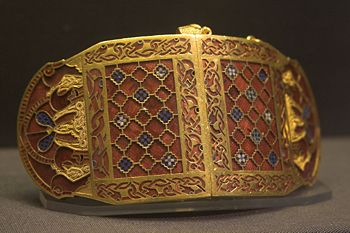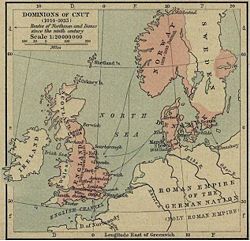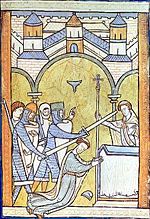Portal:Medieval Britain
2008/9 Schools Wikipedia Selection. Related subjects: British History 1500 and before (including Roman Britain); History; Portals
Great Britain during the Middle Ages (from the 5th century withdrawal of Roman forces from the province of Britannia and the Germanic invasions, until the Early modern period) was fragmented into a number of independent kingdoms. By the High Middle Ages, after the end of the Viking Age and the Norman Conquest, the kingdoms of England and Scotland emerge as the main poles of political power.
The medieval period in England can be dated from the arrival in Kent of Anglo-Saxon troops led by the legendary Hengest and Horsa. Subsequently the Brythonic, Celtic powers were conquered by Jutes, Angles and Saxons Germanic tribes, from the contemporary Angeln and Jutland areas of northern Germany and mainland Denmark. Political takeover of other areas of England proceeded piecemeal and was not completed until the tenth century. Similarly, the end of the medieval period is usually dated by the rise of what is often referred to as the " English Renaissance" in the reign of Henry VIII of England, and the Reformation in Scotland, or else to the establishment of a centralized, bureaucratic monarchy by Henry VII of England. From a political point of view, the Norman Conquest of England divides medieval Britain in two distinct phases of cultural and political history. From a linguistic point of view the Norman Conquest had only a limited effect, Old English evolving into Middle English, although the Anglo Norman language would remain the language of those that ruled for two centuries at least, before mingling with Middle English.
At the height of pre-Norman medieval English power, a single English king ruled from the border with Scotland to the border with Wales to the border with Cornwall. After the Norman Conquest, English power intruded into Wales with increasing vigour, but the process of consolidation was continuous and is not just a medieval feature. The other problem with suggesting such a unity is that the various states had relations with Scandinavia and Continental Europe which are excluded by the concept. For example, northern Scotland often had closer ties with Norway and France (see Auld Alliance) than England or Wales in the medieval period, with Orkney and Shetland only becoming part of Scotland in 1471. Southern England, due to its proximity to Normandy, Flanders and Brittany, had closer relations with them than the other regions. (read more . . . )
Gwynedd in the High Middle Ages is a period of Welsh, British, and European history spanning the 11th, 12th, and 13th centuries (AD 1000–1300). The High Middle Ages were preceded by the Early Middle Ages and followed by the Late Middle Ages. Gwynedd is located in the north of Wales.
Distinctive achievements in Gwynedd during this period include further development of medieval Welsh literature, known as the Beirdd y Tywysogion ( Welsh for Poets of the Princes), the reformation of bardic schools, and the continued development of Cyfraith Hywel (The Law of Hywel, or Welsh law); all three of which further contributed to the development of a Welsh national identity in the face of Anglo-Norman encroachment of Wales.
Gwynedd's traditional territory included Anglesey (Ynys Môn) and all of north Wales between the River Dyfi in the south and River Dee ( Welsh Dyfrdwy) in the northeast. The Irish Sea (Môr Iwerddon) lies to the north and west, and lands formerly part of the Powys border the south-east. Gwynedd's strength was due in part to the region's mountainous geography which made it difficult for foreign invaders to campaign in the country and impose their will effectively. Gwynedd emerged from the Early Middle Ages having suffered from increasing Viking raids and various occupations by rival Welsh princes, causing political and social upheaval. With the historic Aberffraw family displaced, by the mid 11th century Gwynedd was united with the rest of Wales by the conquest of Gruffydd ap Llywelyn, followed by the Norman invasions between 1067 and 1100.
After the restoration of the Aberffraw family in Gwynedd, a series of successful rulers such as Gruffydd I and Owain I in the late 11th and 12th century, and Llywellyn I and Llywelyn II in the 13th century, led to the emergence of the Principality of Wales, based on Gwynedd. The emergence of the principality in the 13th century was proof that all the elements necessary for the growth of Welsh statehood were in place, and Wales was independent de facto, wrote historian Dr. John Davies. As part of the Principality of Wales, Gwynedd would retain Welsh laws and customs and home rule until the Edwardian Conquest of Wales of 1282. (Read more...)
Saint Thomas Becket, St. Thomas of Canterbury, (c. 1118 – 29 December 1170) was Archbishop of Canterbury from 1162 to 1170. He is venerated as a saint and martyr by both the Roman Catholic Church and the Anglican Church. He engaged in conflict with King Henry II over the rights and privileges of the Church and was assassinated by followers of the king in Canterbury Cathedral. He is also commonly known as Thomas à Becket, although this form may not have been contemporaneous.
Thomas Becket was born around 1118 in Cheapside, London, to Gilbert Beket of Thierville and Matilda (with a familiar name of Roheise or Rosea) of Mondeville near Caen. His parents, of the Rouen upper-middle class, were buried in Old St. Paul's Cathedral. One of Thomas's father's rich friends, Richer de L'Aigle, was attracted to Thomas's sisters. He often invited Thomas to his estates in Sussex. There, Thomas learned to ride a horse, hunt, behave like a gentleman, and engage in popular sports such as jousting. Beginning when he was 10, Becket received an excellent education in civil and canon law at Merton Priory in England, and then overseas at Paris, Bologna, and Auxerre. Richer was later a signatory at the Constitutions of Clarendon against Thomas.
Upon returning to the Kingdom of England, he attracted the notice of Theobald, Archbishop of Canterbury, who entrusted him with several important missions to Rome and finally made him Archdeacon of Canterbury and Provost of Beverley. He so distinguished himself by his zeal and efficiency that Theobald recommended him to King Henry II when the important office of Lord Chancellor was vacant. (Read more...)
| “ | We, however, place the love of God and His honour above our own and above the acquisition of many regions. | ” |

Photo Credit: Rob Roy
Shoulder clasp from the burial mound at Sutton Hoo dating from the 6th century and early 7th century. (read more . . . )
- ... that the Unlearned Parliament was so called because lawyers were forbidden to attend as Henry IV (pictured) felt they were "troublesome"??
- ... that the epic poems Beowulf and Judith were written in Late West Saxon?
- ... that the ember days were formerly set aside for fasting and prayer in the liturgical year of the Western churches?
- ... that silver coins in the 10th-century Viking Harrogate Hoard, recovered intact in Yorkshire, January 2007, came from as far as Afghanistan?



